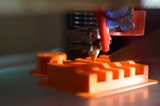
3D printing with students can be daunting. However, these resources are here to help.
- Subject:
- Architecture and Design
- Educational Technology
- Engineering
- Geometry
- Material Type:
- Activity/Lab
- Author:
- Drea Weiner
- Date Added:
- 04/13/2022

3D printing with students can be daunting. However, these resources are here to help.
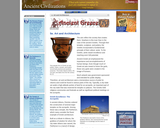
The arts reflect the society that creates them. Nowhere is this truer than in the case of the ancient Greeks. Through their temples, sculpture, and pottery, the Greeks incorporated a fundamental principle of their culture: arete. To the Greeks, arete meant excellence and reaching one's full potential.
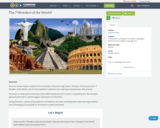
This is an online module created for the 3rd Grade of the Junior High School. The topic of the lesson is the "7 Wonders of the World", and its main emphasis is placed on the Listening comprehension skills practice.
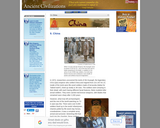
Welcome to the mystery and wonder that is ancient China. In the subsequent readings, you will learn that Chinese culture developed differently from any other ancient civilization. Chinese history is a lesson in paradoxes. Their past is full of natural disasters and wars; yet some of the most beautiful art, literature, and architecture have been created and preserved through the 13 dynastic periods, spanning 4,000 years into the 20th century. These trends are reflected by three of the most influential dynasties of China: the Shang, Han, and Tang.

This course is a continuation of 24.951. This semester the course topics of interest include movement, phrase structure, and the architecture of the grammar.
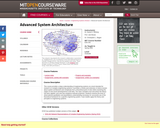
This course provides a deep understanding of engineering systems at a level intended for research on complex engineering systems. It provides a review and extension of what is known about system architecture and complexity from a theoretical point of view while examining the origins of and recent developments in the field. The class considers how and where the theory has been applied, and uses key analytical methods proposed. Students examine the level of observational (qualitative and quantitative) understanding necessary for successful use of the theoretical framework for a specific engineering system. Case studies apply the theory and principles to engineering systems.
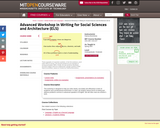
Advanced subject focusing on techniques, format, and prose style used in academic and professional life. Emphasis on writing as required in fields such as economics, political science, and architecture. Short assignments include: business letters, memos, and proposals that lead toward a written term project. Methods designed to deal with the special problems of those whose first language is not English. Successful completion satisfies Phase II of the Writing Requirement. This workshop is designed to help you write clearly, accurately and effectively in both an academic and a professional environment. In class, we analyze various forms of writing and address problems common to advanced speakers of English. We will often read one another's work.
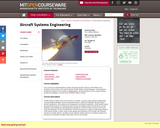
16.885J offers an holistic view of the aircraft as a system, covering: basic systems engineering; cost and weight estimation; basic aircraft performance; safety and reliability; lifecycle topics; aircraft subsystems; risk analysis and management; and system realization. Small student teams retrospectively analyze an existing aircraft covering: key design drivers and decisions; aircraft attributes and subsystems; and operational experience. Oral and written versions of the case study are delivered. For the Fall 2005 term, the class focuses on a systems engineering analysis of the Space Shuttle. It offers study of both design and operations of the shuttle, with frequent lectures by outside experts. Students choose specific shuttle systems for detailed analysis and develop new subsystem designs using state of the art technology.

Alquimétricos is a collection of open source didactic toys: building blocks to mount structures and learn-while-playing about geometry, maths, architecture, mechanics, physics, chemistry, and much more. The initiative is focused on the design of DIY educational materials which are meant to be produced using a wide range of procedures, from ultra-low-cost-low-tech tool set (scissors and nails) to high-end-FabLab-standards (laser cutter, CNC milling, 3D printing), using an equally wide ranged material sort, including recycled packaging plastics, rubbers, cloths and cardboard composites throughout textile-embedded polymers, organic fibers or even lab-harvested fungus. Alquimétricos are meant to play, learn and share.
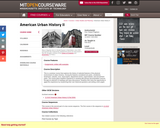
This is a seminar course that explores the history of selected features of the physical environment of urban America. Among the features considered are parks, cemeteries, tenements, suburbs, zoos, skyscrapers, department stores, supermarkets, and amusement parks. The course gives students experience in working with primary documentation sources through its selection of readings and class discussions. Students then have the opportunity to apply this experience by researching their own historical questions and writing a term paper.
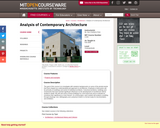
The goal of this course is to investigate with students backgrounds on some of the pivotal events that have shaped our understanding and approach to architecture. Emphasis of discussion will be primarily on buildings and works of individual architects. Canonical architects, buildings and movements that have exerted significant influences on the development of architecture will be studied in detail. We will visit some of these buildings for a first-hand look and to evaluate for ourselves their significance or lack thereof. As a final project, each student will analyze a building through drawings, text, bibliography and a physical model in a format ready for documentation and exhibition.

An analysis of historical structures is presented in this class, presented in themed sections based around construction materials. Structures from all periods of history are analyzed. The goal of the class is to provide an understanding of the preservation of historic structures for all students.
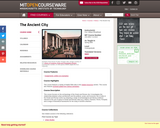
This course focuses on the archaeology of the Greek and Roman city. It investigates the relationship between urban architecture and the political, social, and economic role of cities in the Greek and Roman world. Analyzes a range of archaeological and literary evidence relevant to the use of space in Greek and Roman cities (e.g. Athens, Paestum, Rome, Pompeii) and a range of theoretical frameworks for the study of ancient urbanism.
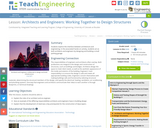
Students explore the interface between architecture and engineering. In the associated hands-on activity, students act as both architects and engineers by designing and building a small parking garage.
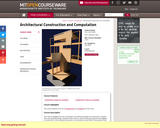
This class investigates the use of computers in architectural design and construction. It begins with a pre-prepared design computer model, which is used for testing and process investigation in construction. It then explores the process of construction from all sides of the practice: detail design, structural design, and both legal and computational issues.
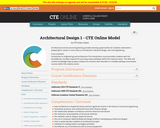
Architectural and Structural Engineering provides learning opportunities for students interested in preparing for careers in such areas as architecture, industrial design, and civil engineering.
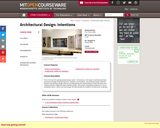
" This is the second undergraduate design studio. It introduces a full range of architectural ideas and issues through drawing exercises, analyses of precedents, and explored design methods. Students will develop design skills by conceptualizing and representing architectural ideas and making aesthetic judgments about building design. Discussions regarding architecture's role in mediating culture, nature and technology will help develop the students' architectural vocabulary."
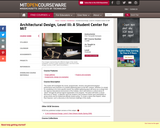
" This studio will investigate the social, programmatic, tectonic and phenomenological performance and character of a student gathering place on the MIT campus. Whether it is simply for socializing or for more specific events, the student gathering place will serve as a refuge from the vigorous educational environment of the Institute, and it will reinforce a critical sense of "place" through the almost logical organization of its program. The place will foster a casual discovery of "being": a reflection upon the student's own existence based upon participation in group events and an intellectual attitude toward acting. To create a space that inspires, rather than imposes: such a discovery is the foremost challenge of this studio."

This semester students are asked to transform the Hereshoff Museum in Bristol, Rhode Island, through processes of erasure and addition. Hereshoff Manufacturing was recognized as one of the premier builders of America's Cup racing boats between 1890's and 1930's. The studio however, is about more then the program. It is about land, water, and wind and the search for expressing materially and tectonically the relationships between these principle conditions. That is, where the land is primarily about stasis (docking, anchoring and referencing our locus), water's fluidity holds the latent promise of movement and freedom. Movement is activated by wind, allowing for negotiating the relationship between water and land.

The project for this studio is to design a demonstration project for a site near the French Quarter in New Orleans. The objectives of the project are the following: To design more intense housing, community, educational and commercial facilities in 4 to 6 story buildings. To explore the "space between" buildings as a way of designing and shaping objects. To design at three scales - dwelling, cluster and overall. To design dwellings where the owners may be able to help build and gain a skill for employment. To provide/design facilities that can help the residents to gain education and skills.